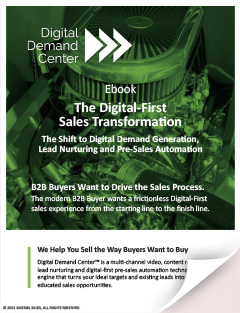 Marketers in nearly all industries are calling 2013 the ‘Year of the Customer’. This insight reflects the fact that in recent years, the sales cycle for B2B companies has shifted to focus much more on consumer demand. Developments in technologies and the globalization of business have created a world where marketers need to meet their prospects and customers on their own level, when and where the customer choses.
Marketers in nearly all industries are calling 2013 the ‘Year of the Customer’. This insight reflects the fact that in recent years, the sales cycle for B2B companies has shifted to focus much more on consumer demand. Developments in technologies and the globalization of business have created a world where marketers need to meet their prospects and customers on their own level, when and where the customer choses.
Customers now want to be treated like individuals with individual needs and desires. For marketers, this means providing individualized marketing content based on each prospect’s preferences and habits. Without marketing automation, this task can be daunting for B2B companies trying to reach hundreds or even thousands of prospects. When leveraged properly through a well-designed content marketing strategy based on buyer insights, a marketing automation solution can severely decrease the workload required for both B2B marketing and sales teams by reaching hundreds of prospects with a few clicks.
There are nearly endless pieces of the B2B sales and marketing process that can be automated with marketing automation. Here are 3 things that B2B marketers should always automate that will drive revenue while simultaneously decreasing the sales effort required to close:
- Customer/Prospect Data. In terms of new prospects, marketing automation is a great way to start a relationship while exerting very little effort. By creating and automating an email “Welcome Campaign,” you can offer basic information about the business problems you solve and request more information regarding prospects’ needs. You can also use marketing automation to maintain your existing customer relationships by asking them to update their information with any recent changes, which may present you with new opportunities to upsell.
- Reviews & Testimonials. Reviews of your product or service by your existing customers have tremendous value in the new, customer-centric sales cycle. Using marketing automation, you can solicit these reviews and then turn them into marketing content in the future. In addition to requesting reviews or testimonials of your product or service, you can ask reviews of the marketing content your prospects engage in as they move through the nurturing process. This will allow you to give your prospects more incentive to engage in your content (e.g. “This whitepaper was extremely insightful on industry changes and offered amazing tips for generating demand!”–John Smith, CEO) while also giving you feedback on how to improve your own marketing strategies.
- Events. Events are becoming more and more popular in B2B sales and marketing. Digital events like webinars and live demos are a great way to generate new leads and educate and nurture prospects. You can use marketing automation to send out many different types of messages related to an event, depending on a prospect’s behavior. After the initial invitation, you can automate different responses based on if the invitation was opened or if the prospect registered for the event. You can also automate “thank you for attending” emails containing new marketing content to prospects who actually attended your event while sending “sorry we missed you” emails offering recorded versions of the event to no-shows.
Marketing automation has the potential to take all (or at least most) of the guesswork out of the B2B sales cycle. Using marketing automation, you can gather customer insights at the same time you nurture prospects and close deals. Marketing automation puts the information you need to sell at your fingertips, as long as you know what to do with it.
If you would like to know more about how marketing automation helps B2B companies streamline their sales and marketing efforts into one easy-to-manage process, please feel free to contact us.




